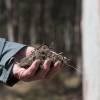
Audit requirements cut for low-risk plantation projects
Posted 02 September 2024
Economic benefits and markets Carbon benefits
The audit requirements for low-risk plantation forestry projects in the Australian Carbon Credit Unit (ACCU) Scheme have been reduced to one scheduled audit.
This aligns with the Clean Energy Regulator’s risk-based approach to manage compliance. It ensures that audits are targeted to situations where they can provide the greatest value in supporting the integrity of the Australian Carbon Credit Unit (ACCU) Scheme.
Low-risk plantation forestry projects that opt-in are instead subject to alternative assurance arrangements. These arrangements reduce administrative burden and incentivise scheme participation by lowering costs.
Private Forests Tasmania made a submission in early 2024 in support of the change, which could potentially save eligible plantation forestry projects tens of thousands of dollars in audit costs.
Eligibility
The project must:
- be covered by either or both Schedule 1 (new plantations) and Schedule 2 (conversion of short to long rotation plantation forests) of the 2022 plantation forestry method
- have an anticipated and reported carbon estimation area of no more than 200 hectares
- agree to be subject to geospatial monitoring and other compliance checks by the Clean Energy Regulator.
Existing and new projects are both eligible for the new arrangements.
Eligible projects registered under the 2017 plantation forestry method must vary to the 2022 method to apply for alternative assurance arrangements.
Maintaining integrity
Approved low-risk plantation forestry projects undertake an initial audit only. Primarily, this ensures the project follows the method and checks that the calculation tool, FullCAM, is calibrated correctly.
To support the reduced number of audits, the Clean Energy Regulator will use geospatial tools and other measures, including site visits and inspections, to verify carbon abatement is being achieved.
The Clean Energy Regulator said it has a high degree of confidence in using these tools to monitor the integrity of these projects because a plantation:
- is readily observable
- is planted uniformly
- typically, consists of one species.
Participants will be able to opt-in to the alternative assurance arrangements for eligible projects through the Clean Energy Regulator's website soon.
Share this Article
Latest Articles
-

20 October 2025
Tasmanian High Soil Carbon Landscapes project
-

17 September 2025
Celebrating excellence at the Tasmanian Timber Awards
-

17 September 2025
Forest Practices Authority Research Update Day
Archives
- ActivAcre hits milestone, calls for more farmers to get on board
- Napier's leading the way in sustainable forestry and carbon-neutral farming
- Sound science needed to assess carbon impacts of timber harvesting
- Newly appointed TFFPN Board of Directors
- Graduate Certificate of Forestry Scholarship
- Forestry Australia Mentoring Program 2025
- Forest Industry Roundtable planning for the long term
- Eagle Management Constraint Period extended
- Successful private native forest management celebrated
- $15 million investment in new ship loader to boost Bell Bay's forestry exports
- Standing with Tasmania's forestry industry: buy local
- TFPA: Tasmanian Freight Equalisation Scheme needs a ground-up review
- AFCA Gala Dinner celebrates industry excellence
- Fire permits now required Statewide
- Forest leaders hone skills in sustainable native regrowth management
- Tasmanian forests and the carbon market: Barriers and opportunities
- What the 2024-25 Tasmanian Budget means for forestry
- Spring is the time for fuel reduction burning
- Primed for Growth: A situation analysis of the Tasmanian Forest and Wood Products Sector
- Audit requirements cut for low-risk plantation projects
- Guidance and support for landowners after damaging winds
- Forestry Australia welcomes further definition of active forest management
- Farm & Forest Mapper Tool highlighted at Rural Youth Tasmania's Young Farmer of the Year competition
- Senate Select Committee inquiry into the Tasmanian Freight Equalisation Scheme
- Timberlink announces new wood composite products brand
- Newly developed protocol a vital tool for safeguarding forestry industry
- Red Hot Tips: Fire management for Tassie farmers
- Bioenergy: Fuelling industries with trees
- Harvesting trees: What you need to know
- Shelterbelts: How are they contributing to farm systems?
- Infill plantings and remnant vegetation: Why biodiversity depends on a thriving understory
- Plantation planning: The key to a successful plantation
- Exciting interactive forestry knowledge hub launched
- $450,000 farm forestry grant recipients revealed


